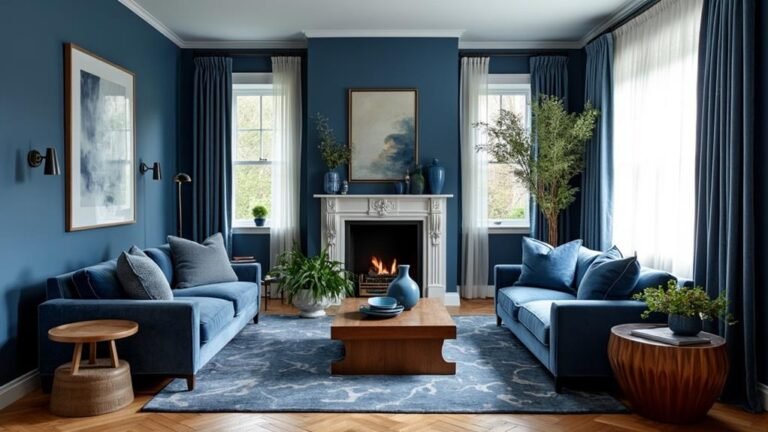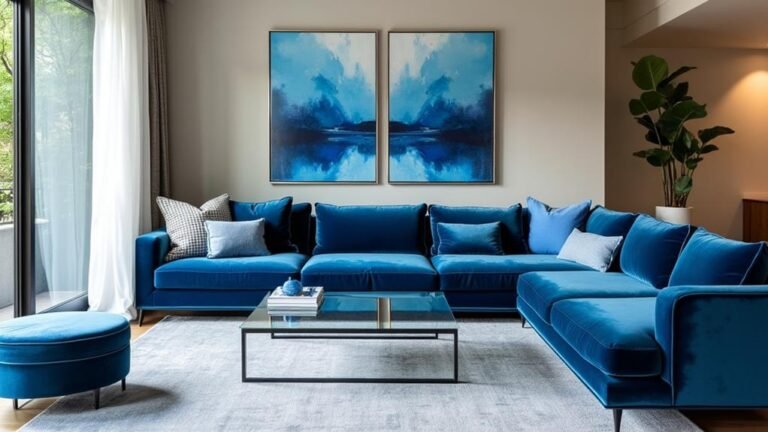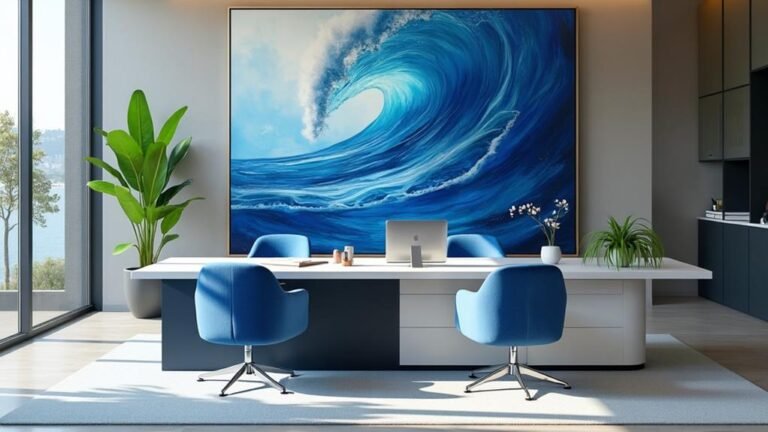How Can I Mix Different Shades of Blue in My Office Without Clashing?
Mixing different shades of blue in your office without clashing isn’t as tricky as it might seem. Start by picking a main blue tone you love – maybe a soft sky blue or a deep navy. This will be your foundation.
From there, you can add other blue shades that work well together.
Think about how different blues can complement each other. You don’t want them to fight for attention. Adding textures and patterns can help break up solid colors and create visual interest. This could be through throw pillows, curtains, or even wallpaper.
To create a cohesive look that boosts productivity, consider these tactics:
- Use the 60-30-10 rule: 60% dominant color, 30% secondary color, and 10% accent color.
- Incorporate neutral colors like white, gray, or beige to balance the blues.
- Choose blue shades with similar undertones (warm or cool) for harmony.
- Add metallic accents in silver or gold to enhance the blue palette.
- Use lighter blues for larger surfaces and darker blues for smaller accents.
By following these tips, you can create a blue office space that’s both visually appealing and conducive to work.
Understanding Color Theory

Color theory is a key idea that can make your office look great. When you get it, you’ll make better design choices. It’s all about how colors work together and affect our feelings and how we see things. Learning this helps you create a space that feels just right.
Let’s break down some important parts of color theory:
- Color Wheel Basics: Think of a wheel with all the colors. You’ve got primary colors (red, blue, yellow) that mix to make secondary colors (green, orange, purple).
- Complementary Colors: These are colors opposite each other on the wheel. Put them together, and wow! They really stand out. Blue and orange, for example, can make your workspace feel lively.
- Analogous Colors: These colors sit next to each other on the wheel. Picture blue, teal, and green. Using these can make your office feel peaceful and put-together.
- Warm vs. Cool Colors: Warm colors like reds and oranges pump you up. Cool colors like blues and greens help you chill out. Think about what you want your office to feel like when you pick colors.
Understanding these ideas can really help you create an office space that looks good and feels right. It’s not just about making things pretty – it’s about creating a space that works for you and your team.
Choosing the Right Shades

When choosing blue shades for your office, think about the vibe you want to create. Different blues can make you feel different ways, so consider your goals. These four tips can help:
- Know Your Purpose: What’s your office mainly for? If you need to focus, go for a calm feel. Want to boost creativity? Think lively.
- Pick Your Main Blue: Start with one main shade. Light blues are peaceful, while darker ones add a fancy touch.
- Blend with Other Blues: Find blues that work well together. Try pairing a soft sky blue with a deep navy for a nice balance.
- Try Before You Buy: Paint small areas on your walls first. See how the colors look in your office lighting at different times of day.
These tips are practical and easy to follow. They’ll help you choose blues that match your office needs and personal style. Remember, the right shades can make a big difference in how you feel at work.
Using Accessories for Balance
Accessories can really help balance the different shades of blue in your office. They tie everything together and make it look cohesive. Check out these accessory ideas:
| Accessory Type | Purpose |
|---|---|
| Throw Pillows | Add comfort and introduce new blue tones. |
| Desk Accessories | Use items like pen holders or organizers. |
| Artwork | Choose pieces that incorporate diverse blues. |
| Rugs | Anchor the space while blending shades. |
| Curtains | Soften light and add depth to your colors. |
When picking accessories, think about how intense your blues are. Lighter shades can brighten things up, while darker ones add a touch of sophistication. It’s a good idea to mix in some complementary colors, like white or gray, to create contrast and make things more interesting visually. Don’t go overboard, though. Focus on a few key pieces that really stand out instead of cluttering the space.
Incorporating Patterns and Textures

Incorporating patterns and textures into your office design can enhance the look of different blue shades. Careful selection of these elements creates a unified appearance that’s both inviting and professional. Consider these tips:
- Textiles: Choose patterned cushions or throws in various blue tones. Fabrics add warmth and comfort while breaking up solid colors.
- Wall Art: Check out artwork featuring diverse blue patterns. This might include abstract designs or photos with blue tones that match your color scheme.
- Rugs: A patterned rug can ground the space and blend different blue shades. Look for designs with multiple blues or a contrasting color for balance.
- Furniture: When possible, go for furniture with textured finishes. A velvet chair in deep blue, for example, adds sophistication and depth to your office.
These suggestions help create a visually interesting space that maintains a professional atmosphere. By mixing patterns and textures, you’ll avoid a monotonous look while still keeping a cohesive blue theme. Remember to balance bold patterns with more subtle elements to prevent overwhelming the space.
Creating Focal Points

Creating focal points in your office is key to drawing attention and improving the overall design. You can create visual interest and balance by strategically placing elements.
Some ideas to consider:
- Accent Wall: Pick a bold blue shade for one wall. This can be the backdrop for your desk or artwork.
- Artwork: Hang a big piece that uses different shades of blue. It’ll add depth and tie the room together.
- Furniture Pieces: Use a unique blue chair or stylish bookshelf as a statement. These can be both useful and eye-catching.
- Decorative Accessories: Put cushions, vases, or books in various blue shades on your desk or shelves. This creates layers without crowding the space.
- Rugs: A rug with mixed blue tones can ground the room and grab attention, making a cozy spot.
These ideas help create focal points that enhance your office design while keeping the blue theme consistent. They’re practical ways to add visual interest without overdoing it.
Lighting Considerations

Lighting plays a big role in making your blue office look great. Good lighting brings out the best in your chosen shades, while poor lighting can make things clash or look off. Keep these tips in mind when picking lights for your blue-themed office:
- Natural Light: Let in as much sunlight as you can. It shows the true colors of your paint and decor, making blues look bright and fresh.
- Color Temperature: Go for warm light bulbs (around 2700K to 3000K). They work well with cool blue tones and create a balanced feel.
- Layered Lighting: Use different types of lights. Mix overhead lights, desk lamps, and accent lights to light up your space well and show off your blues.
- Dimmers: Put in dimmer switches. You can adjust the light levels as the day goes on, setting the right mood and highlighting your chosen shades.
These tips will help you create an office that looks good and shows off your blue color scheme nicely.
Conclusion
Mixing different shades of blue in your office can create a calming and inspiring atmosphere. To make it work, you’ll want to understand a bit about color theory and pick the right tones. This way, you can get a cohesive look.
Don’t forget about accessories and patterns – they can add depth to your design. It’s also a good idea to create focal points and think about lighting. These elements will really enhance the overall feel of the space.
By following these tips, you’ll end up with a stylish office that boosts both productivity and creativity. Remember, there’s no need to stick to rigid rules. Have fun with it and let your personal style come through in the design.






